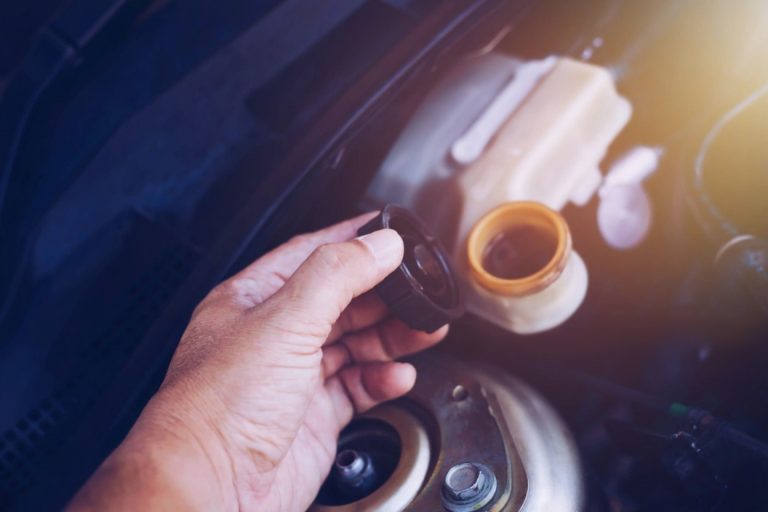Brake fluid color can tell you a lot about your car’s health. A simple color chart helps drivers understand when it’s time to flush or change their fluid. Each shade carries a signal about performance and safety. Clear or light amber means it’s fresh, while dark brown or black shows it’s worn out.
In this guide, we’ll break down the brake fluid color chart and how it applies to DOT 3, 4, and 5.1 types. Learning the brake fluid color meaning helps you prevent brake failure and keep your vehicle running safely on the road.
Brake Fluid Colors Meaning: Fresh vs Dirty
New brake fluid typically appears light yellow or amber on the brake fluid color chart, signifying purity and performance. The color of brake fluid changes as it absorbs water and debris. Fluid boiling point decreases with moisture absorption, affecting braking performance.
Dusty brake fluid is dark brown or black. The fluid is stale, unclean, and decomposing. Brakes can fail and be damaged by dark fluid.
Changed brake fluid color indicates needing replacement. If the brake fluid gets dark brown or black, it needs to be changed. By monitoring fluid color, brakes may be kept safe and effective.
Brake Fluid Color Chart: Visual and Explanation
The brake fluid color meaning indicates the condition of the fluid and whether it is safe to use or needs to be changed.

Fresh Fluid Colors
New brake fluid is mostly transparent, minor yellow, or amber. This implies that the oil is neat and in good circulation to ensure that your brakes work. New brake fluid appears clear and transparent meaning that it does not contain moisture and contaminant.
Aging Fluid Colors
When the brake fluid grows older, it turns darker in tone to yellow or brown. This is because the brake fluid takes in moisture through the air hence resulting in the fluid being worn out. Darker fluid and then you know that the brake system is not working as effectively as it should be and you need to change the fluid in the near future.
Severely Contaminated Fluid Colors.
If the braking fluid is dark brown or black, it is highly polluted. This colour signifies that there is dirt, moisture and particles accumulated in the fluid. A warning that the brake fluid is not safe anymore and requires immediate replacement is black or dark brown. Bad brake fluid may lead to your brake failure and will result in damaging your braking system.
Comparing DOT Brake Fluid Types: Table & Key Facts
| DOT Type | Composition | Dry Boiling Point (°C/°F) | Wet Boiling Point (°C/°F) | Water Absorption | Key Characteristics | Meaning | Use |
| DOT 3 | Glycol Ether | 205°C / 401°F | 140°C / 284°F | Hygroscopic | Most common type, absorbs water gradually | Basic glycol-based brake fluid standard | Used in most cars and trucks |
| DOT 4 | Glycol Ether + Borate Ester | 230°C / 446°F | 155°C / 311°F | Hygroscopic | Higher boiling points; better for ABS | Enhanced glycol-based fluid for safety | Used in vehicles with ABS and higher performance needs |
| DOT 5 | Silicone-based | 260°C / 500°F | 180°C / 356°F | Hydrophobic | Does not absorb water, incompatible with glycol fluids | Silicone-based fluid, non-hygroscopic | Used in classic cars; not compatible with modern ABS |
| DOT 5.1 | Glycol Ether + Borate Ester | 260°C / 500°F | 180°C / 356°F | Hygroscopic | High boiling point; compatible with DOT 3 and DOT 4 | High-performance glycol-based fluid | Used in high-performance and heavy-duty vehicles |
How to Check Brake Fluid Color and What To Do?
It is easy to check the colour of your brake fluid as well as it is important to be safe on the road. Here are the steps to follow and the way it is done safely.
Step 1: Find the Brake Fluid Reservoir.
Locate the brake fluid tank being the underhood of your car. It is a small transparent container in the back of the engine compartment. The reservoir will be marked in terms of fluid level min and max.
Step 2: Inspect the Fluid Color
Examine the fluid under the transparent reservoir. Available brake fluid is typically transparent, light yellow, or amber. When the fluid is dark yellow, brown or black in color, it is an indication that the fluid is old or contaminated as well.
Step 3: Feel the Fluid (Optional)
Provided there is the opportunity, wet a clean finger or cloth in the fluid. Fresh fluid feels smooth. When it is gritty, then it is an indication that dirt or the particles are present in the inside and the fluid should be replaced.
Step 4: Design Replacement (Where necessary).
When the braking fluid is dark or appears dirty then it is time to flush with a professional and replace the fluid. Dark brake fluid may lower the effectiveness of braking and result in damage.
Step 5: Regular Checks
Test the brake fluid color after every few months or once a year at least. It is recommended that your brakes be examined on a regular basis to ensure that they are in good condition and that you avoid expensive repairs.
Maintenance Tips for Brake Fluid Health
Braking can only be safe and effective when the brake fluid is properly maintained. These are some easy ways of maintaining good brake fluid.
Check Fluid Level Regularly
Check the brake fluid reservoir after every one month. The fluid mark must be in between the minimum and maximum marks. When it is low, put in the right form of brake fluid that is suggested in the manual of your vehicle.
Watch the Fluid Color
New brake fluid is clear or light brown. When the fluid appears either dark or opaque, it implies that it has taken up moisture or contaminating elements and it needs to be changed.
Changing Schedule Brake Fluid.
The brake fluid is usually changed after 1- 2 years or as recommended by your car manufacturer. Brake fluid contains moisture and this causes the boiling point of the brake fluid to lower hence causing brake failure.
Use the Correct Type
Always ensure that you use the type of brake fluid that your car needs which is normally either DOT 3, DOT 4, or DOT 5.1. Poor choice of fluid or fluid mixing may destroy your brake system.
Prevent Contamination
Also make sure that the brake fluid reservoir is well sealed so that dirt and moisture does not get into it. Do not top up your brake fluid with old/broken bottles.
Have Regular Inspections
Have your brakes system checked by a professional mechanic at least once a year. They would be able to test the leaks, fluid state, and general brakes condition.
Conclusion
The brake fluid color chart would allow you to be aware of when the fluid requires your attention. Every color depicts a various phase of fluid life and performance. Healthy is light or clear fluid and dirty or dark is an indication that it is time to change.
It is also important to know the difference between the DOT 3, 4 and 5.1 fluids to guarantee the correct fluid to the car. To avoid brake failure and make sure your vehicle is safe, it is important to check them regularly and replace them in time. You shouldn’t wait till it starts leaking – make sure that your brake fluid is good today and be sure of everything on the road.
FAQs
Is Purple Brake Fluid Normal?
Purple brake fluid is not normal. It may indicate mixing of different brake fluids or contamination. Always replace it with the correct type to ensure safe braking performance.
What Does Milky Brake Fluid Mean?
Milky brake fluid means water or air has mixed with the fluid. This reduces braking power and can cause brake failure. Replace it immediately for safe driving.
Can Temperature Change Brake Fluid Color?
Yes, high temperatures can darken brake fluid over time. Heat causes the fluid to break down faster, leading to a darker color and reduced braking performance.


